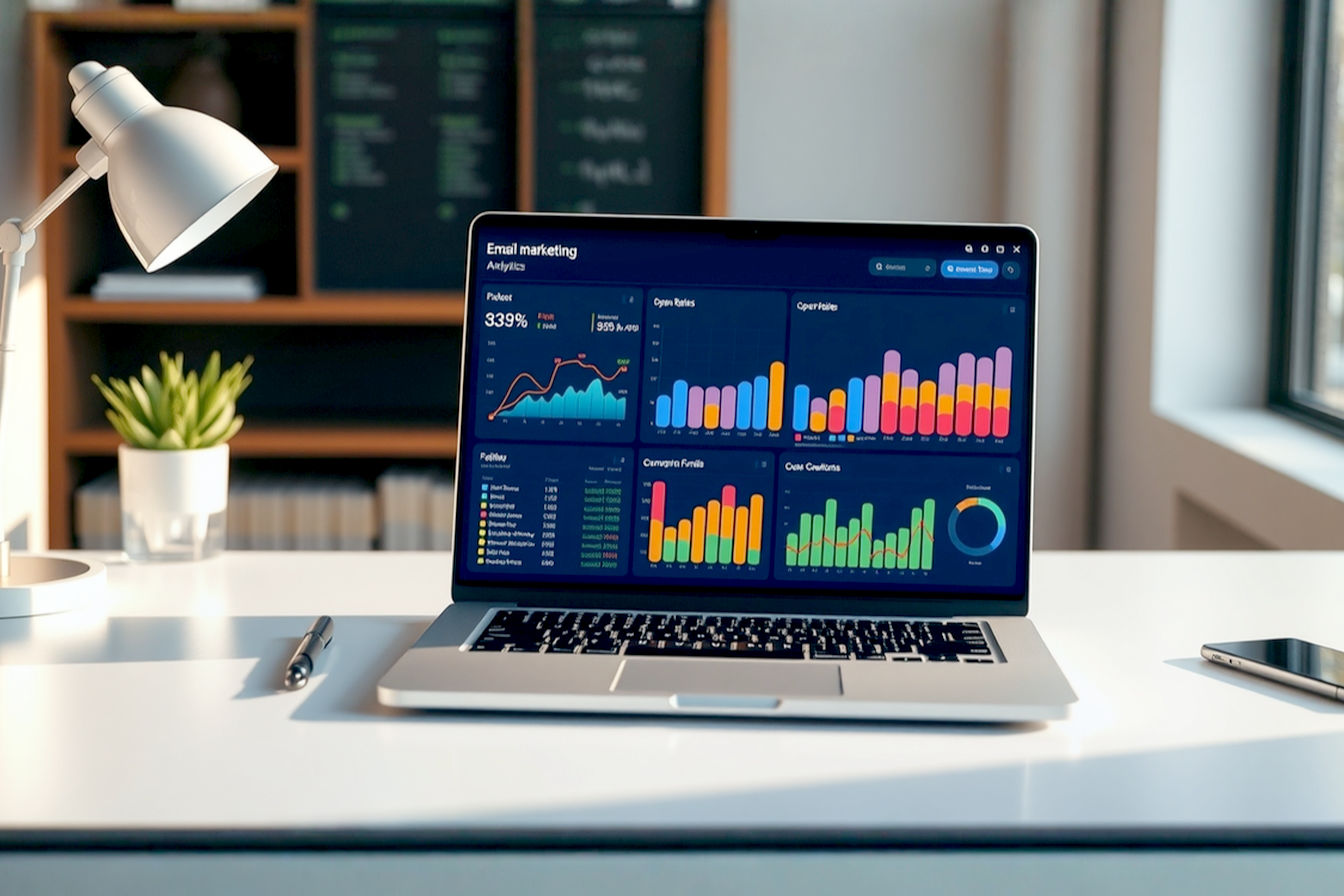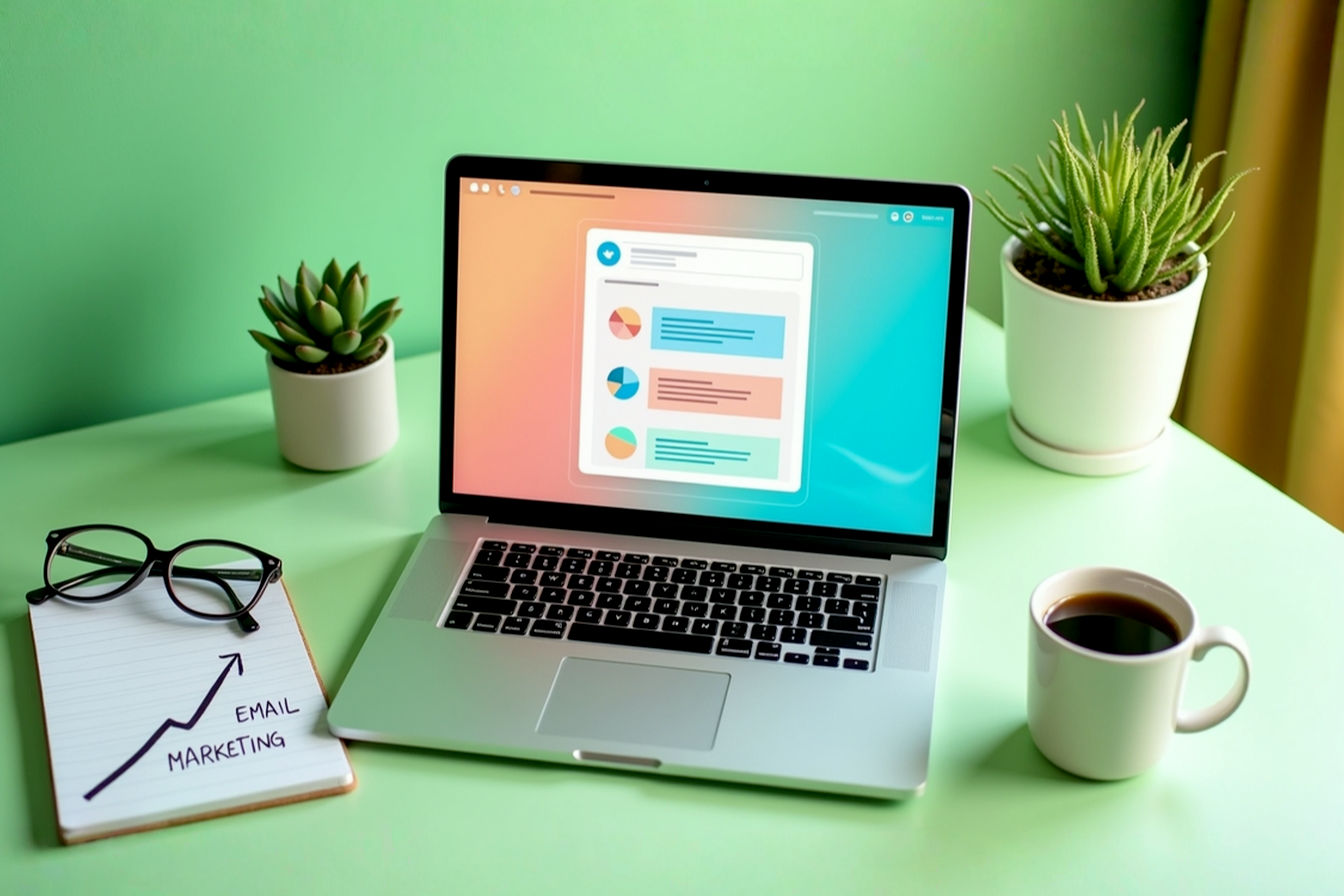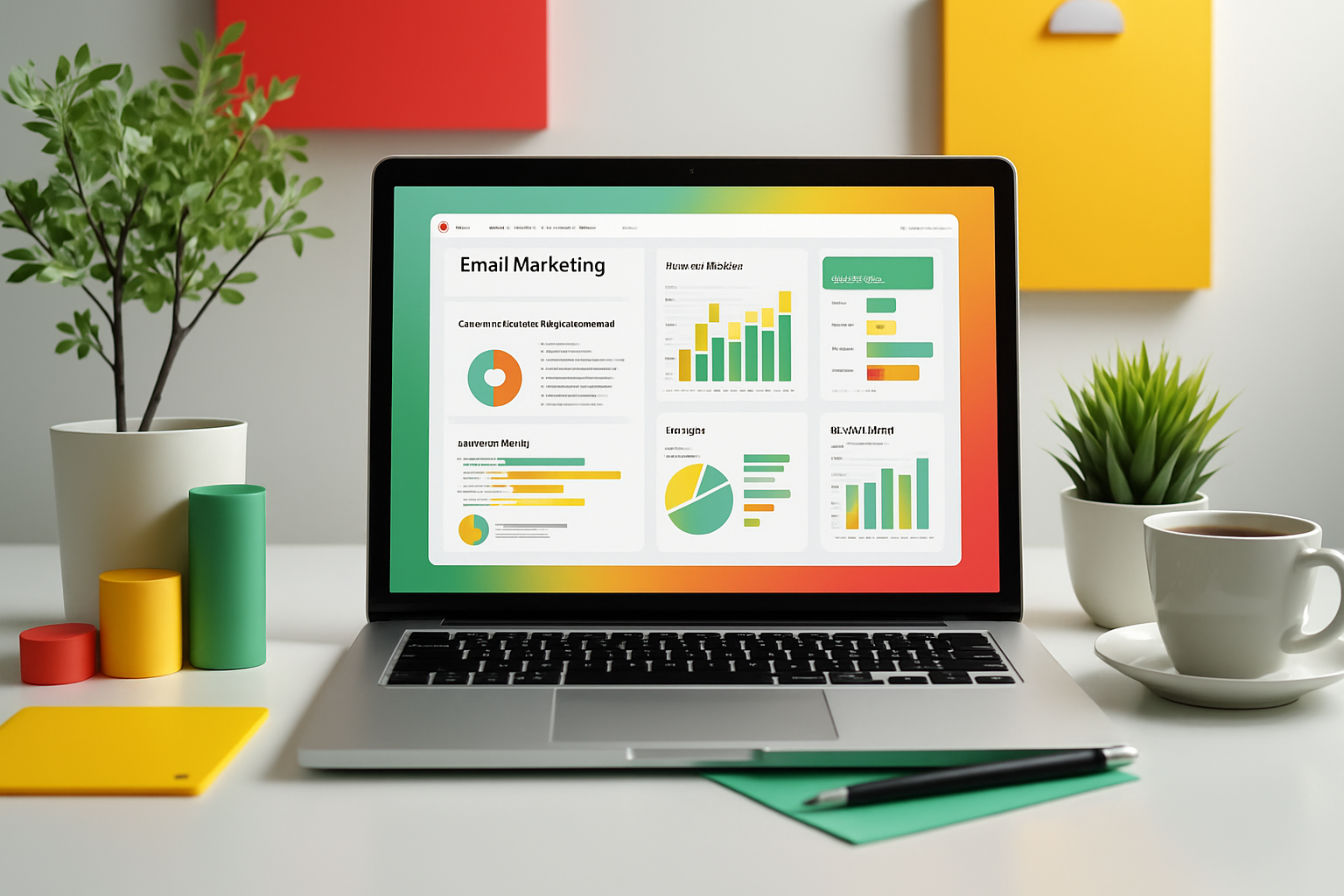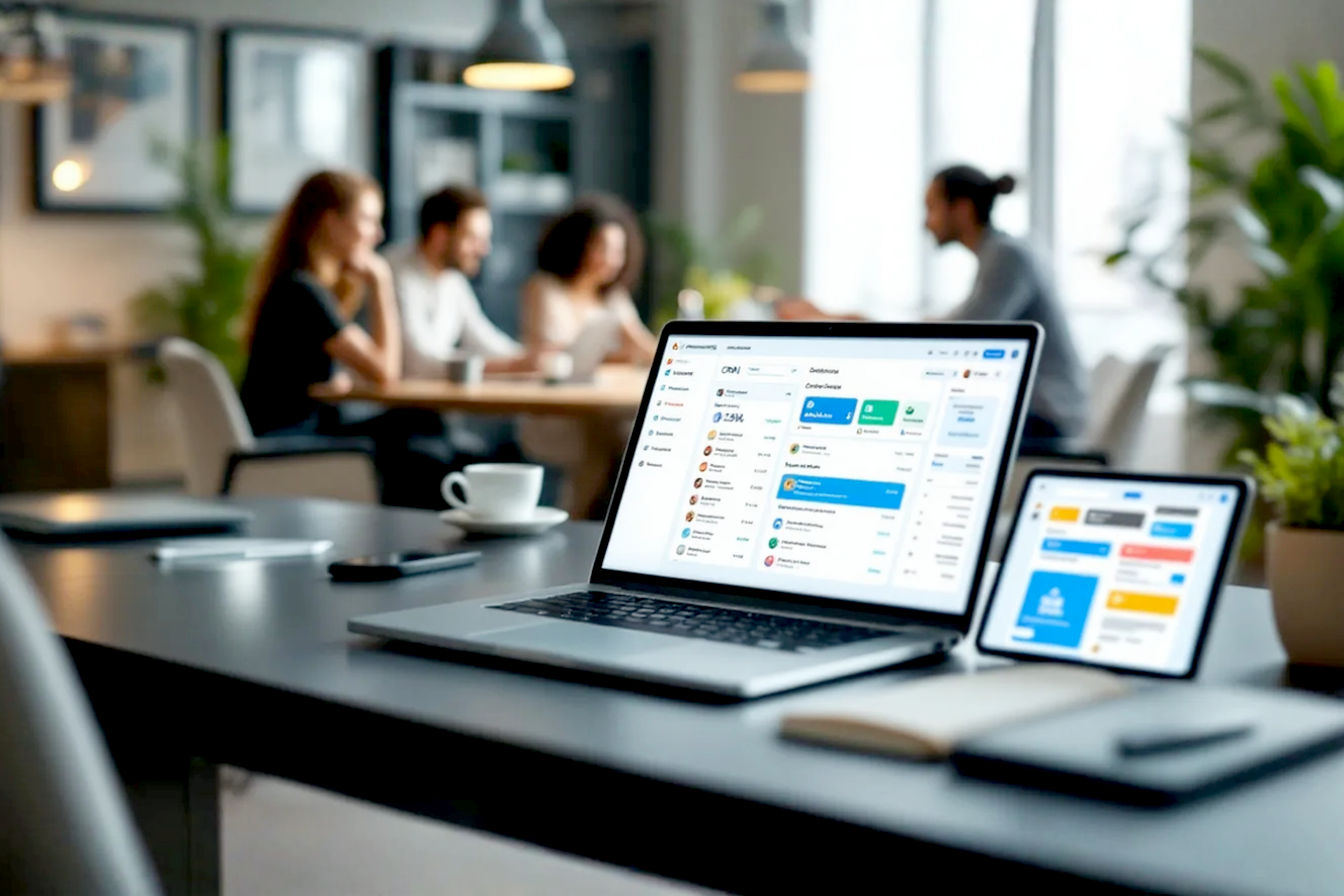This post may contain affiliate links. If you make a purchase through these links, we may earn a commission at no additional cost to you.
Email marketing remains one of the most powerful tools in a digital marketer’s arsenal. But simply sending out newsletters isn’t enough to turn casual browsers into loyal buyers. You need a strategic approach – an email marketing funnel. This guide will walk you through everything you need to know to design and implement email funnels that effectively nurture leads and significantly boost your conversions. We’ll explore what these funnels are, why they’re crucial, and how to build one step-by-step, transforming your email list into a predictable source of revenue.
Understanding the Power of Email Marketing Funnels
Before we dive into the “how-to,” it’s essential to grasp the “what” and “why.” Understanding the fundamental concepts behind email marketing funnels will set you up for success.
What Exactly is an Email Marketing Funnel? (And Why You Need One)
Think of an email marketing funnel as a carefully planned journey you create for your potential customers. It’s a series of automated emails designed to guide individuals from their first point of contact with your brand (like signing up for a newsletter or downloading a resource) all the way to making a purchase, and even beyond.
- Defining the Email Funnel: More Than Just EmailsAn email funnel isn’t just a random collection of emails. It’s a strategic sequence, where each email serves a specific purpose, building upon the last. It’s like a virtual salesperson working for you 24/7, understanding where each prospect is in their decision-making process and delivering the right message at the right time. This targeted approach is far more effective than generic email blasts.
- The Core Goal: Guiding Visitors to Become Loyal CustomersThe ultimate aim of any email marketing funnel is conversion. This could mean a direct sale, a subscription to a service, or another desired action. But it’s not just about that first conversion. A well-designed funnel also focuses on building relationships, fostering loyalty, and encouraging repeat business, turning one-time buyers into long-term advocates for your brand.
- Key Benefits: Automation, Personalization, and ScalabilityThe beauty of email funnels lies in their efficiency and effectiveness.
- Automation: Once set up, the funnel works automatically. New subscribers enter the sequence, and emails are sent based on pre-defined triggers (like time delays or specific actions taken by the user). This saves you an enormous amount of time and effort.
- Personalization: Modern email marketing platforms allow for sophisticated segmentation. This means you can tailor messages based on a subscriber’s interests, behavior, or demographics, making your communication far more relevant and impactful. Imagine sending different email sequences to someone who downloaded a beginner’s guide versus someone who viewed your advanced product page – that’s the power of personalization.
- Scalability: Whether you have 100 subscribers or 100,000, a well-built email funnel can handle it. As your audience grows, your funnel continues to nurture leads and drive sales without requiring a proportional increase in your manual workload.
How Email Funnels Differ from Traditional Email Marketing
Many businesses engage in email marketing, but not all are leveraging funnels. Traditional email marketing often involves sending out periodic newsletters, promotional blasts, or company updates to an entire list. While this has its place, it lacks the strategic, journey-based approach of a funnel.
- Beyond Blasts: The Strategic Journey ApproachEmail funnels are different because they map out a specific path for the subscriber. Instead of a one-size-fits-all message, each email is a step in a larger strategy. This journey-centric model acknowledges that not everyone is ready to buy immediately. Some need more information, some need to build trust, and some need a gentle nudge. An email funnel caters to these varying needs systematically.
- Mapping to the Customer Lifecycle: Awareness to AdvocacyA robust email funnel mirrors the customer lifecycle. It starts by attracting individuals who are just becoming aware of your brand (Awareness), then nurtures their interest and helps them consider your solutions (Interest & Consideration), guides them toward making a purchase (Decision/Action), and finally, encourages them to become repeat buyers and advocates (Loyalty & Advocacy). This alignment ensures that your messaging is always relevant to where the customer is in their relationship with your brand.
The Psychology Behind Why Email Funnels Work
Email funnels are effective because they tap into fundamental human psychology. Understanding these principles can help you craft even more compelling sequences.
- Building Trust and Rapport Over TimePeople buy from those they know, like, and trust. An email funnel provides a consistent, non-intrusive way to build this trust. By regularly delivering valuable content, sharing insights, and addressing pain points, you position your brand as a helpful authority. Each email is an opportunity to strengthen that rapport.
- The Principle of Reciprocity: Providing Value FirstWhen you offer something of value for free (like a helpful ebook, a checklist, or an informative webinar – often called a lead magnet), people feel a natural inclination to reciprocate. This doesn’t necessarily mean an immediate purchase, but it makes them more receptive to your future communications and offers. The initial stages of an email funnel are often built around this principle, providing value before asking for a sale.
- Scarcity and Urgency in Email SequencesEthically applied, scarcity (limited availability) and urgency (limited-time offers) can be powerful motivators. If a prospect is on the fence, a well-timed email highlighting a special discount that’s about to expire or a product with limited stock can encourage them to take action. These tactics are typically used towards the bottom of the funnel, once sufficient value and trust have been established.
The Anatomy of a High-Converting Email Funnel: Key Stages
A successful email marketing funnel typically moves prospects through several distinct stages. While the specifics can vary based on your business and industry, the underlying progression is generally consistent.
Stage 1: Awareness – Attracting Potential Leads (Top of Funnel – TOFU)
This is where it all begins. The goal at the top of the funnel (TOFU) is to attract potential customers and get them to opt-in to your email list. You’re essentially exchanging valuable content for their email address.
- Lead Magnets that Work: Offering Irresistible ValueA lead magnet is a free resource or offer you provide in exchange for an email address. To be effective, it must be highly valuable and relevant to your target audience.
- Examples: Ebooks, Checklists, Webinars, Free Trials, Templates, Discount Codes, Quizzes, Case Studies.For instance, a software company might offer a “Free 14-Day Trial,” while a marketing consultant could offer a “Definitive Guide to SEO.” The key is that the lead magnet solves a specific problem or provides a quick win for your ideal customer.
- Crafting Compelling Opt-in Forms and Landing PagesYour opt-in form is the gateway to your funnel. It needs to be clear, concise, and compelling.
- Simplicity is Key: Only ask for essential information (usually just an email address, maybe a first name).
- Strong Call-to-Action (CTA): Use clear, action-oriented language (e.g., “Download Your Free Guide Now,” “Get Instant Access”).
- Benefit-Oriented Headline: Highlight what the user will gain. Landing pages dedicated to your lead magnet often convert better than forms embedded on a busy homepage. A good landing page focuses solely on the value of the lead magnet and the action of signing up.
- Driving Traffic to Your Opt-in OpportunitiesYou can have the best lead magnet and opt-in form, but they’re useless without traffic. Promote your lead magnets through:
- Social media posts and ads
- Blog posts and website banners
- Search engine optimization (SEO)
- Guest blogging
- Partnerships
Stage 2: Interest & Consideration – Nurturing Your Leads (Middle of Funnel – MOFU)
Once someone subscribes, they enter the middle of the funnel (MOFU). Here, the focus shifts to nurturing these new leads, building relationships, and educating them about how your products or services can solve their problems.
- The Welcome Email Series: Making a Strong First ImpressionThe first few emails a new subscriber receives are crucial. A welcome email series (typically 3-5 emails) sets the tone for your relationship.
- Content Ideas:
- Welcome & Delivery: Thank them for subscribing, deliver the promised lead magnet, and briefly introduce your brand.
- Your Story/Mission: Share your brand’s story or mission to build a connection.
- Value & Education: Provide additional helpful tips, resources, or insights related to the lead magnet.
- Problem/Solution: Highlight a common problem your audience faces and tease how your offerings can help.
- Set Expectations: Let them know what kind of content they can expect from you and how often.
- Content Ideas:
- Educating and Engaging: Providing Solutions and Building AuthorityBeyond the welcome series, MOFU emails should continue to provide value. This isn’t the time for a hard sell. Instead, focus on:
- Types of Nurturing Emails:
- Educational Content: Blog post snippets, how-to guides, industry news, tips and tricks.
- Case Studies & Testimonials: Show social proof by highlighting how others have benefited from your solutions.
- Webinar Invitations: Offer deeper dives into relevant topics.
- Behind-the-Scenes Content: Humanize your brand. The goal is to position yourself as a trusted expert and keep your brand top-of-mind.
- Types of Nurturing Emails:
- Segmentation: Delivering Personalized ContentNot all leads are created equal, and their needs can differ. Segmentation involves dividing your email list into smaller groups based on shared characteristics or behaviors.
- Why Segmentation Matters for Conversion:Segmented campaigns consistently outperform non-segmented ones because the content is more relevant. Relevant content leads to higher engagement (opens, clicks) and, ultimately, more conversions.
- Common Segmentation Strategies:
- Demographic: Age, gender, location, job title.
- Behavioral: Past purchases, website pages visited, email engagement (opened/clicked specific links), lead magnet downloaded.
- Interest-Based: Subscribers indicate their interests through a preference center or based on content they interact with. For example, if someone clicked on links related to “beginner tips” in your emails, you could segment them into a “beginner” group and send them more foundational content.
Stage 3: Decision – Converting Leads into Customers (Bottom of Funnel – BOFU)
At the bottom of the funnel (BOFU), your leads are more informed and closer to making a purchasing decision. Now, you can start introducing your offers more directly, but still with a focus on value.
- Crafting Persuasive Sales Emails Without Being PushyThe key is to focus on how your product or service solves the lead’s problem or helps them achieve their goals.
- Highlighting Benefits Over Features:Instead of just listing features (e.g., “Our software has a 10GB storage capacity”), explain the benefit (e.g., “Our software provides 10GB of storage, so you can securely store all your important project files without worrying about running out of space”).
- Addressing Objections Proactively:Think about common questions or concerns potential customers might have and address them in your emails (e.g., in an FAQ section or by weaving answers into your copy).
- Special Offers, Discounts, and Limited-Time DealsA well-timed offer can be the catalyst that converts a lead into a customer. This could be:
- A percentage discount (e.g., “Get 20% off your first month”)
- A bonus product or service
- Free shipping
- An exclusive bundle
- The Role of Urgency and Scarcity (Ethically Applied)As mentioned earlier, urgency (“Offer ends Friday!”) or scarcity (“Only 10 spots left!”) can encourage action. However, always use these tactics honestly. Fabricated scarcity can damage trust.
Stage 4: Action – The Purchase or Conversion
This is the moment of truth – when the lead takes the desired action, typically making a purchase.
- Streamlining the Checkout Process (If Applicable)If your funnel leads to an online purchase, ensure your checkout process is as simple and frictionless as possible. A complicated checkout is a major conversion killer. Minimize steps, offer guest checkout, and provide multiple payment options.
- Confirmation and Thank You Emails: Reinforcing the DecisionImmediately after a purchase, send a confirmation email. This should:
- Confirm the order details.
- Provide any necessary next steps (e.g., how to access a digital product, shipping information).
- Thank the customer and reinforce that they made a good decision. This helps reduce buyer’s remorse.
Stage 5: Loyalty & Advocacy – Turning Customers into Fans (Post-Funnel)
The funnel doesn’t end with the first purchase. The post-funnel stage is about nurturing customer loyalty and encouraging them to become advocates for your brand.
- Onboarding New Customers EffectivelyIf your product or service requires setup or learning, a dedicated onboarding email sequence can greatly improve customer satisfaction and retention. Guide them through the initial steps and highlight key features.
- Encouraging Repeat Purchases and UpsellsExisting customers are often your best source of future revenue. Send targeted emails with:
- Recommendations for complementary products (cross-sells).
- Information about premium versions or add-ons (upsells).
- Exclusive offers for existing customers.
- Requesting Reviews and ReferralsHappy customers can be powerful marketers for you. After they’ve had a positive experience, send an email asking for a review or testimonial. You can also implement a referral program to incentivize them to spread the word.
- Building a Community Around Your BrandInvite customers to join your social media groups, forums, or exclusive communities. This fosters a sense of belonging and strengthens their connection to your brand.
Designing Your Email Marketing Funnel: A Step-by-Step Guide
Now that you understand the stages, let’s walk through the practical steps of designing your own high-converting email funnel.
Step 1: Define Your Goals and Target Audience
Before you write a single email, you need clarity on what you want to achieve and who you’re trying to reach.
- What Do You Want to Achieve with Your Funnel?Be specific. Is your primary goal to:
- Sell a specific product?
- Generate leads for a high-ticket service?
- Increase webinar attendance?
- Drive free trial sign-ups? Your goal will dictate the structure and content of your funnel. For example, a funnel for a $10 ebook will look very different from a funnel for a $2,000 coaching program.
- Creating Detailed Buyer PersonasA buyer persona is a semi-fictional representation of your ideal customer based on market research and real data about your existing customers. A detailed persona includes:
- Demographics (age, gender, location, income, education)
- Psychographics (interests, values, lifestyle, pain points, goals, challenges)
- Behavioral traits (how they research products, what motivates their purchases) Understanding your buyer persona helps you tailor your lead magnet, email copy, and offers to resonate deeply with their needs and desires.
Step 2: Choose Your Lead Magnet(s)
Your lead magnet is the entry point to your funnel. It needs to be irresistible to your target audience.
- Aligning Lead Magnets with Audience Needs and Funnel StageConsider what your buyer persona is struggling with or aspiring to achieve. Your lead magnet should offer a tangible solution or a quick win related to that. For example:
- If your audience wants to learn a new skill, offer a beginner’s guide or a cheat sheet.
- If they’re looking for tools, offer a template or a resource list.
- If they need to make a decision, offer a comparison guide or a case study. Ensure the lead magnet naturally leads towards your core product or service.
Step 3: Map Out Your Email Sequence and Content
This is where you plan the actual journey for your subscribers.
- Determining the Number of Emails and CadenceThere’s no magic number for emails in a sequence. It depends on your goal, your product’s complexity, and your audience.
- Welcome/Nurturing sequences: Often 3-7 emails sent over 1-2 weeks.
- Launch sequences: Can be longer and more intensive, perhaps 7-10 emails over 2-3 weeks.
- Abandoned cart sequences: Typically 1-3 emails sent within 24-48 hours. Cadence (how often you send emails) is also important. You want to stay top-of-mind without overwhelming subscribers. Start with a slightly higher frequency for welcome emails (e.g., daily or every other day) and then potentially space them out more for longer nurturing sequences.
- Planning Content for Each Email in the SequenceFor each email, define its specific purpose. Ask yourself:
- What is the one key message I want to convey?
- What action do I want the subscriber to take (if any)? (e.g., read a blog post, watch a video, register for a webinar, consider an offer)
- How does this email move the subscriber closer to the funnel’s overall goal? Outline the key points for each email. This will make the writing process much smoother.
- Writing Compelling Subject Lines and Email CopyYour email copy needs to be engaging, persuasive, and value-driven.
- Tips for High Open Rates and Click-Through Rates:
- Subject Lines: Make them clear, concise, and curiosity-inducing. Use personalization (like the subscriber’s name) where appropriate. A/B test different subject lines to see what works best. Avoid spammy words or excessive capitalization.
- Email Body:
- Start with a strong hook.
- Keep paragraphs short and scannable. Use bullet points and subheadings.
- Write in a conversational, relatable tone.
- Focus on benefits, not just features.
- Include a clear Call-to-Action (CTA) in each email. Make it obvious what you want them to do next.
- Proofread meticulously for grammar and spelling errors.
- Tips for High Open Rates and Click-Through Rates:
Step 4: Select Your Email Marketing Platform
You’ll need software to manage your list, send emails, and automate your funnels.
- Key Features to Look For: Automation, Segmentation, Analytics
- Automation: The ability to create automated workflows based on triggers (e.g., sign-ups, clicks, purchases) and time delays. This is the backbone of an email funnel.
- Segmentation: Tools to easily divide your list into targeted groups.
- Tagging: Applying labels (tags) to subscribers based on their actions or interests for more granular segmentation.
- Analytics & Reporting: Detailed stats on open rates, click-through rates, conversion rates, etc., to measure performance.
- Ease of Use: An intuitive interface for building emails and automation.
- Integrations: Compatibility with other tools you use (e.g., your website platform, CRM, e-commerce store).
- Popular Email Marketing Tools (Brief Overview)Many excellent platforms are available, each with its strengths:
- Mailchimp: User-friendly, great for beginners, good all-around features.
- ConvertKit: Designed for creators (bloggers, course creators), strong on automation and tagging.
- ActiveCampaign: Powerful automation and CRM capabilities, suitable for more advanced marketers.
- GetResponse: Offers a suite of tools including webinars and landing pages alongside email marketing.
- MailerLite: Known for its clean interface and good free plan. Research a few options to find the one that best fits your needs and budget.
Step 5: Build and Automate Your Funnel
Once you have your plan and platform, it’s time to build.
- Setting Up Automation Rules and TriggersIn your email marketing platform, you’ll create an automation workflow. This involves:
- Defining the Entry Trigger: What action starts the funnel (e.g., a subscriber joins a specific list after downloading a lead magnet).
- Adding Email Steps: Drag and drop your planned emails into the sequence.
- Setting Time Delays: Specify how long to wait between sending emails (e.g., wait 1 day, then send next email).
- Adding Conditional Logic (If/Else): More advanced funnels can use conditional logic. For example, “IF subscriber clicks link A in email 1, THEN send email 2A. ELSE, send email 2B.” This allows for highly personalized paths.
- Designing Email Templates for Brand ConsistencyMost platforms offer pre-designed templates or allow you to create your own. Ensure your emails:
- Are visually appealing and easy to read.
- Reflect your brand’s colors, logo, and fonts.
- Are mobile-responsive (look good on all devices).
Step 6: Implement Tracking and Analytics
You can’t improve what you don’t measure. Tracking is crucial for understanding how your email funnel design is performing.
- Key Performance Indicators (KPIs) to Monitor
- Opt-in Rate: Percentage of visitors who sign up for your lead magnet.
- Open Rate: Percentage of recipients who open your emails. (Average is around 15-25%, but varies by industry).
- Click-Through Rate (CTR): Percentage of recipients who click on a link within your email.
- Conversion Rate: Percentage of recipients who complete the desired action (e.g., make a purchase, sign up for a webinar). This is the ultimate measure of your funnel’s success.
- Unsubscribe Rate: Percentage of recipients who opt out of your list. A high rate might indicate issues with content relevance or frequency.
- Bounce Rate: Percentage of emails that couldn’t be delivered. (Hard bounces are permanent, like invalid email addresses; soft bounces are temporary).
- Understanding Your Funnel’s Performance DataRegularly review your KPIs for each email in the sequence and for the funnel as a whole. This data will reveal:
- Which emails are performing well.
- Where subscribers might be dropping off.
- Opportunities for improvement.
Optimizing Your Email Funnel for Maximum Conversions
Building your funnel is just the start. Continuous optimization is key to maximizing its effectiveness and achieving the best possible email conversion optimization.
A/B Testing Your Emails and Funnel Components
A/B testing (or split testing) involves creating two versions of an email or funnel element (e.g., Version A and Version B) and sending them to different segments of your audience to see which performs better.
- What to Test: Subject Lines, CTAs, Copy, Design, TimingYou can test almost anything:
- Subject Lines: This is a common and impactful element to test.
- Call-to-Action (CTA) Button: Text, color, size, placement.
- Email Copy: Tone, length, specific offers, headline.
- Email Design/Layout: Use of images, overall structure.
- Sending Time/Day: When your audience is most receptive.
- From Name: Your company name vs. a personal name. Only test one variable at a time to accurately attribute any performance difference.
- How to Conduct Effective A/B Tests
- Define Your Goal: What do you want to improve (e.g., open rate, CTR)?
- Formulate a Hypothesis: “I believe changing the CTA button color from blue to green will increase CTR.”
- Create Variations: Design your A and B versions.
- Determine Sample Size: Ensure your test groups are large enough for statistically significant results. Many email platforms handle this.
- Run the Test: Send the variations simultaneously.
- Analyze Results: Identify the winner and implement the changes.
- Repeat: A/B testing is an ongoing process.
Refining Your Segmentation and Personalization Strategies
As you gather more data about your subscribers, you can refine your segmentation.
- Using Behavioral Triggers for Dynamic ContentMany email platforms allow you to use behavioral triggers to send highly relevant emails or even change parts of an email dynamically. Examples:
- If a subscriber visits a specific product page on your website multiple times but doesn’t purchase, you could trigger an email with more information about that product or a special offer.
- If a subscriber clicks a link about “advanced techniques” in one email, future emails could automatically include more advanced content for them. Dynamic content allows you to show different blocks of text or images within the same email to different segments, making your messages incredibly personalized without having to create dozens of separate emails.
Addressing Funnel Leaks: Where Are Visitors Dropping Off?
A “leak” in your funnel is a point where a significant number of subscribers stop engaging or drop out of the sequence.
- Analyzing Data to Identify BottlenecksLook at your email-by-email analytics. Is there a particular email with a very low open rate or CTR? That could be a bottleneck. Are people unsubscribing after a specific message? Investigate why.
- Strategies to Re-engage Dormant LeadsIf leads become inactive (stop opening your emails), you can try a re-engagement campaign. This is a short series of emails specifically designed to win them back or, if they remain unresponsive, to remove them from your active list (which helps with list hygiene).
The Importance of Mobile Responsiveness in Email Design
A significant portion of emails are opened on mobile devices. If your emails aren’t optimized for mobile, you’re likely losing engagement and conversions.
- Responsive Design: Use email templates that automatically adjust their layout to fit any screen size.
- Readable Fonts: Choose clear, legible fonts that are easy to read on small screens.
- Tap-Friendly CTAs: Ensure buttons and links are large enough to be easily tapped with a finger.
- Concise Content: Mobile users often scan quickly, so keep your message focused.
Ensuring Deliverability: Avoiding the Spam Folder
Your brilliant emails are useless if they land in the spam folder. Email deliverability is the ability to get your emails into the recipient’s inbox.
- Maintaining List HygieneRegularly clean your email list by:
- Removing invalid email addresses (hard bounces).
- Removing subscribers who consistently don’t engage (after trying to re-engage them). A clean list improves your sender reputation and deliverability.
- Authentication (SPF, DKIM, DMARC) – Simplified ExplanationThese are technical standards that help prove to Internet Service Providers (ISPs) like Gmail and Outlook that you are a legitimate sender and not a spammer.
- Think of it like this: When you send a letter, the post office looks at the return address and stamp to verify it’s likely legitimate. SPF, DKIM, and DMARC are like digital stamps and verifications for your emails.
- SPF (Sender Policy Framework): Specifies which mail servers are authorized to send emails on behalf of your domain. It’s like saying, “Only emails coming from these specific postal codes are officially from me.”
- DKIM (DomainKeys Identified Mail): Adds a digital signature to your emails. This signature is verified by the recipient’s email server to ensure the email hasn’t been tampered with in transit. It’s like a tamper-proof seal on your envelope.
- DMARC (Domain-based Message Authentication, Reporting & Conformance): Tells ISPs what to do if an email claims to be from you but fails SPF or DKIM checks (e.g., reject it, mark it as spam, or deliver it). It also provides reports on email activity. Most email marketing platforms provide guidance on setting these up, or do so automatically for you. Ensuring they are correctly configured is crucial for good deliverability.
Advanced Email Funnel Strategies and Examples
Once you’ve mastered the basics, you can explore more specialized types of email funnels.
The Abandoned Cart Email Funnel
For e-commerce businesses, this is a must-have. When a shopper adds items to their cart but leaves without completing the purchase, an automated abandoned cart email sequence can recover a significant portion of these potentially lost sales.
- Timing and Content:
- Email 1 (within 1-2 hours): A gentle reminder. “Did you forget something?” Include images of the cart items and a direct link back to their cart.
- Email 2 (within 24 hours): Address potential concerns (e.g., offer help, highlight customer support, mention return policy). Sometimes a small incentive like free shipping is included here.
- Email 3 (optional, 48-72 hours): A final reminder, perhaps with a limited-time discount or highlighting scarcity if applicable.
The Webinar Funnel
Webinars are a great way to generate leads and sell higher-ticket items. A webinar funnel automates the promotion and follow-up.
- Pre-Webinar Engagement: Emails to drive registrations, reminders leading up to the event, and emails to build excitement (e.g., sharing what attendees will learn, speaker bios).
- Live Event Promotion: “Going live soon!” reminders.
- Post-Webinar Follow-up:
- For attendees: Thank you email, link to the replay, presentation slides, and often, the main offer discussed during the webinar.
- For registrants who didn’t attend: Link to the replay, summary of key points, and the offer.
- For those who didn’t register but might be interested: A separate sequence highlighting the value and offering access to the replay (perhaps as a new lead magnet).
The Product Launch Funnel
Used when introducing a new product or service. This funnel builds anticipation and drives a surge of sales during the launch period.
- Pre-Prelaunch (optional): Gauge interest, tease the upcoming solution.
- Prelaunch: Build anticipation, reveal details about the product, share behind-the-scenes content, address pain points the product solves.
- Launch: Announce the product is available, highlight special launch offers/bonuses, use social proof (early testimonials).
- Post-Launch: Address latecomers, extend offers (sometimes with a “last chance” angle), or transition into an evergreen funnel.
The Re-engagement Funnel for Inactive Subscribers
Also known as a “win-back” campaign. This targets subscribers who haven’t opened or clicked your emails in a while (e.g., 3-6 months).
- Email 1: A friendly check-in. “Are we still a good fit?” Remind them of the value you provide.
- Email 2: Offer a special incentive to re-engage (e.g., a unique discount, a valuable piece of content).
- Email 3 (optional): A final “goodbye” email, letting them know you’ll remove them from your active list if they don’t take action (often with an option to stay subscribed). This helps clean your list and improve overall engagement rates.
Common Pitfalls to Avoid When Building Email Funnels
While powerful, email funnels can go wrong if not implemented thoughtfully. Here are some common mistakes:
- Over-Complicating the FunnelEspecially when starting, keep it simple. A complex, multi-branching funnel can be difficult to manage and troubleshoot. Start with a straightforward sequence and add complexity as you gain experience and data.
- Not Providing Enough ValueIf your emails are all about selling without offering genuine value (education, entertainment, solutions), subscribers will quickly tune out or unsubscribe. Remember the principle of reciprocity.
- Inconsistent Branding or MessagingYour emails should have a consistent look, feel, and tone of voice that aligns with your overall brand. Conflicting messages or a disjointed visual style can confuse subscribers.
- Ignoring Mobile UsersAs emphasized before, failing to design for mobile means alienating a large portion of your audience.
- Failing to Test and OptimizeSetting up a funnel and then forgetting about it is a missed opportunity. Regularly analyze performance and A/B test to continuously improve results.
- Poor List Management PracticesNot cleaning your list, sending to unengaged subscribers indefinitely, or making it difficult to unsubscribe can harm your sender reputation and deliverability.
Conclusion: Start Building Your High-Converting Email Funnel Today
Designing effective email marketing funnels is an investment that pays dividends in lead generation, customer acquisition, and long-term brand loyalty. By understanding the psychology, stages, and strategic steps involved, you can transform your email list from a simple database into a dynamic engine for growth.
Recap of Key Takeaways:
- Email funnels guide prospects on a journey from awareness to advocacy.
- They rely on automation, personalization, and providing consistent value.
- Key stages include Awareness (lead magnets), Interest/Consideration (nurturing), Decision (offers), Action (purchase), and Loyalty (retention).
- A step-by-step design process involves defining goals, choosing lead magnets, mapping sequences, selecting tools, building automation, and tracking KPIs.
- Continuous optimization through A/B testing, refined segmentation, and ensuring deliverability is crucial for success.
Don’t be intimidated by the process. Start with a simple funnel, perhaps a welcome series for new subscribers that leads to an introductory offer. As you gain confidence and gather data, you can build more sophisticated sequences. The key is to start, learn, and iterate. Your efforts to create thoughtful, value-driven email funnels that convert will undoubtedly reward you with more engaged subscribers and, ultimately, more paying customers.






